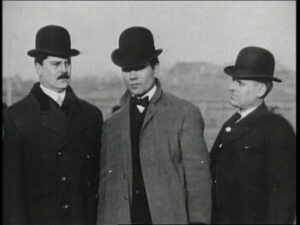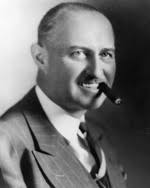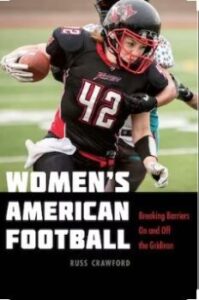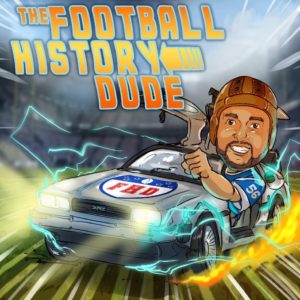This episode we fire up the DeLorean and head back to explore the life and career of Joe Carr, the Father of Professional Football.
He was the NFL President from 1921 – 1939 and was considered one of the most influential people in bringing legitimacy to the league.
Due to his contributions to the league, Joe Carr was inducted to the Pro Football Hall of Fame in the inaugural class of 1963. So strap on your seat belt, and let’s get ready to take this baby up to 88mph.
LISTEN ON YOUR APP OF CHOICE
Joe Carr's Early Life
As we step off our DeLorean this episode in Columbus, OH. The date is October 23, 1879, the day our hero was born. Our hero is Joseph Francis Carr, and he would become The Father of Professional Football.
Joe Carr would accomplish this through his 19 years as the President of the NFL (from 1921 – 1939). An article from Pro Football Researchers Association said he only had 5 years of formal education, at St. Dominic’s Elementary School. At the age of 13, he went to work for a local machine shop to support the family. He would work as a machinist for the Panhandle Division of the Pennsylvania Railroad and he would also be a sportswriter for the Columbus Newspaper.
Throughout his tenure, he was involved in founding the famous Panhandle White Sox in 1900. He would also revive the Columbus Panhandle football team, which was made up of mostly railroad employees.
His team would have the famous Nesser Brothers. The Nesser brothers were a famous group of brothers that all played for the same professional football team. For the majority of the time, 5 of the 11 starters on the team were Nesser’s.
The 6th brother would end up joining the team in 1910, making the majority of the starters made up of Nesser’s. Fred, Frank, Phil, John, Ted, and Al were the brothers. In 1921, Ted’s son joined the team to form what would be believed as the only father/son combo on the same team in professional football.
Carr would end up having many opportunities in the future throughout his Presidency of the NFL to make many changes.

First Season of APFA
The first season of the American Professional Football Association would ultimately be successful, although many things needed to be changed before it would turn into the NFL we know today. Apparently, after the September 17, 1920 meeting, it was said to be a requirement for a $100 membership fee.
However, it was rumored nobody ever paid. Scheduling was also left to the teams, with really no rules for what teams they could play against or how many games they had to play. The original teams came from 4 states. From Ohio were the Akron Pros, Canton Bulldogs, Cleveland Indians, and Dayton Triangles.
The Hammond Pros and Muncie Flyers were from Indiana. New York had the Rochester Jefferson’s and the Rock Island Independents hailed from Illinois. There would be 4 more teams that would join throughout the season. These teams were the Buffalo All-Americans, Chicago Tigers, Columbus Panthers, and Detroit Heralds.
On September 26, 1920, the first game featuring an APFA team would occur. At Rock Island’s Douglas Park in front of 800 people, the Rock Island Independents defeated the St. Paul Ideals 48-0. This was against a non-APFA team.
The first game featuring 2 APFA teams happened on October 3, 1920. Some have pointed to the game of Dayton Triangles versus Columbus Panhandles, which would result in Dayton winning 14-0. It was said the game between the Muncie Flyers and Rock Island Independents also occurred the same day, but the Dayton game would be considered the first game due to a matter of time zones.
There were a few different beliefs for the person that scored the first touchdown. An article on NFL.com declared Lou Partlow of Dayton possibly scored the first touchdown between APFA teams.
In the same game, Dayton’s Frank Bacon would end up scoring the league’s first punt return for a touchdown for 60 yards. However, it was thought possibly the first score came between Muncie and Rock Island because the Dayton and Columbus game was scoreless through the first half. Rock Island kicked off the ball to Muncie, but it was said Muncie met a stone wall in the first drive.
As Ken Huffine punted, Rock Island tackle Ed Shaw roared in to block the punt. Former Minnesota All-American Arnie Wyman picked the ball up and ran it back for a 35-yard touchdown.
Later in the season, it was rumored a game between the Chicago Cardinals and Tigers and Chicago Cub’s Park was the reason the Tigers fizzled out. Legend had it the owner of the Cardinals, Chris O’Brien, bet the owner of the Tigers that the loser would shut their respective team down the following year.
However, the more realistic reason was probably due to the dwindling attendance and losing that caused the team to lose too much money.
One of the darker sides of the season was a player named George Trafton of the Decatur Staley’s. He was known by many as “The Beast” for his dirty play. Trafton had a run-in with the fans on November 7th, 1921 against the Rock Island Independents. Many players were taken out of the game for the Independents, and an infamous play occurred when Trafton “almost decapitated Hal Grunderson when he slid across his face in a pile-up.”
Headlines of the ARGUS would state “Staley’s Win World’s Dirt Title” and “Unsportsmanlike Conduct of Starchmen an Utter Affront to Fair Name of Clean Sport.” The first game between the teams Trafton had fans bust the window out of his tax and he had to hop out to catch a ride with a random passer-by.
After the second game between the teams, coach George Halas gave Trafton the Staley’s share of the gate receipts ($7,000) and told him to “meet back at the hotel.” Later Halas would say “I figured he’d run faster than I was. He was running for his life. I would have just been running for seven thousand.”
Ultimately, the 1920 season would come down to 3 teams vying for the championship.
Originally the teams agreed to award the champion by January, but it would take all the way until a meeting on April 30, 1921, to finally award the Akron Pros with the 1920 championship.

Re-Organization of the APFA
The APFA was re-organized after the 1920 season. Joe Carr of the Columbus Panhandles was named the President and Carl Storck from Dayton was named the secretary-treasurer. Carr would make the decision to move the APFA headquarters to Columbus, OH.
The committee would draft the new league constitution and by-laws. Part of the changes would include giving teams territorial rights, restricting player movements, developing membership criteria for franchises, and issuing standings to be able to have a clear champion.
The next meeting would occur on June 18, 1921, at the Hollenden Hotel in Cleveland to ratify the new constitution and to approach the topic of scheduling. Two of the major components discussed in the meeting would include preventing contract jumping and eliminating the use of collegiate players.
The 3rd meeting in 1921 occurred on August 27th in Chicago at the LaSalle Hotel. It was said this was possibly the first time George Halas was at one of the meetings because Ralph Hay reported the Canton Bulldogs would play the Decatur Staley’s in Chicago on October 30th, and Halas was the only person believed to be able to make scheduling decisions.
In 1921, the association also grew to 22 members. The Green Bay Packers would come into the picture during this season. The team was awarded to John Clair of the Acme Packing Company, which originally purchased the Indian Packing company. During the 1921 season, Thorpe would also move to the Cleveland Indians. A.E. Staley of the Decatur Staley’s would end up turning the team over to George Halas, who would move the team to Chicago Cub Park. Staley paid $5,000 to Halas to keep the name Staley’s for one more year.
At the commencement of the 1921 season, the Staley’s would claim the championship with a 9-1-1 record. The Buffalo All-Americans had a record of 9-1-2. President Joe Carr ruled in favor of Decatur as the champions, thus resulting in George Halas’ first championship.
Incorporating original interviews and actual newspaper accounts, Chris Willis recreates the largely forgotten story of this unique squad of men.
1922 Name Change to NFL
During the 1921 season, Clair and Green Bay admitted the use of players with college eligibility, so they withdrew from the APFA. Curly Lambeau promised to follow the rules and used $50 of his own money to buy back the team. Harsh weather and low attendance would end up leading to Lambeau going broke.
Local merchants led by Press-Gazette general manager Andrew B. Turnbull arranged a $2,500 loan for the club and a public non-profit set up to run the team. Lambeau would be named the head coach and manager. Fans were able to purchase shares of stock in the Packers for $5, which would also come with a season ticket.
A meeting in Cleveland, OH at the Hollenden Hotel would bring together the owners of the teams. The meeting occurred on June 24-25, 1922. There were 20 clubs that met for this meeting, which would provide some interesting amendments to the 2-year old constitution. During the meeting, the owners would also allow an insurance agent to take 15 minutes to make a spiel about protecting the league from long-term liability.
One of the outcomes of the amendments to the constitution was the guaranteeing of salaries to referees, even if the game was not played. Also, President Joe Carr would schedule which refs would in charge for each game, instead of allowing the teams to decide the refs of their own.
It would be determined the length of the 1922 season would be from October 1 to December 10, with an added stipulation the teams must have no less than 7 and no more than 13 games played, to be considered official for the league standings. Joe Carr had experience in the minor baseball leagues as an executive, so he used his expertise to present a “reserve clause” for players.
It was said Halas and Sternman “ran afoul of the clause at the June meeting.” Another major change was this was the first time the league would really buckle down on the use of collegiate players in professional games. The first offense would result in a fine for the team, and the 2nd offense would result in expulsion from the league.
Another problem was collegiate players were “moonlighting,” meaning they were using false names to be able to play for professional teams. It was decided if a collegiate player was caught doing this, he would be expelled from the league forever.
The salary cap was another point of contention. It was at first decided the league would impose a $1,800 salary cap per game, but there was a difference of opinions regarding exactly what would be counted towards this salary cap. Some teams wanted only the player salaries to count, while others wanted the expenses of getting the players to the game to count, as well.
The primary teams on the latter side were Chicago and Buffalo. This was believed to be mostly because they had more home games than away games, which would result in an advantage for them by freeing up more cash for them to give to higher-paid salaries.
A meeting in Dayton on August 20, 1922, would “gut” the Decatur Staley’s because the team “no longer existed.”
This meant all the players were free agents. George Halas had major clout, so many of the players went back to the Chicago Bears with Halas. However, it was said Guy Chamberlain hurt the most. He would sign a new contract to play for Ralph Hay’s Canton Bulldogs. The rest of the meeting didn’t do much other than shrinking the salary cap down to $1,200 per game, but it would only include the salaries of the players.
Owners would also vote to include a clause that players wouldn’t be paid if “the game was canceled for reasons unavoidable or beyond the control of management.”
Players and owners would have some workarounds to get past the salary cap limitation. One quote found was “look, we’ll just put down $100 on the contract we file with the league, but after the game, we’ll give you an extra hundred.”
This was considered to be a common arrangement. However, it made me think to the Pudge Heffelfinger episode of the Football History Dude where we discussed the first documented professional football player, and how he had made $500 for one game 30 years earlier.
Another workaround was the teams would give star players $100 for playing, and then they would also list that player as the coach, meaning they could give them more money. Teams would carry 16 players, which is a far cry from the 53-man roster on current NFL teams.
A quote about the direction of the league showed how the owners felt they were going the right way. It said the league “went from a flabby group of poor-mouths desperately trying to get independent teams to join up to a moderately muscular bunch, tough to get in and tougher still (on paper) to get out.”
Perhaps the most important change, though, was this was the first time the name would be changed from the American Professional Football Association to the National Football League.
Recognizing Joe Carr
A bio from the Pro Football Hall of Fame gives you more information about the entire career of Joe Carr, but there were a few points to highlight. Joe Carr gave the NFL stability, displayed integrity with rigid standards, introduced player’s contracts, barred the use of collegiate players in the NFL, and worked tirelessly to interest financially-capable new owners.
The NFL MVP award would be awarded under Carr’s name from 1938-1946. He would end up passing away on May 20, 1939, at the age of 59. A quote from George Halas summed up how much Joe Carr meant to the league.
He stated, “Professional football’s remarkable growth and popularity today is not the result of the efforts of anyone owner or group of owners. It is due entirely to Mr. Carr’s fair and impartial administration of its affairs and his steadfast belief in the game.”
LIKE THIS ARTICLE? PLEASE CONSIDER SHARING
Why is Ralph Hay Considered the Founder of the NFL?
In this episode, we fire up the DeLorean and head...
Read MoreThe Making of Women’s American Football: Breaking Barriers On and Off the Field
This week Russ Crawford, Professor of History at Ohio Northern...
Read MoreThe Quarterback Project: Do You Agree With Michael Mertes and His Top QB’s?
This week I spoke with Michael Mertes about a project...
Read MoreSpies on the Sidelines: How Much of an Impact Does Spying Have in the NFL?
While the phrase “three-letter agency” is a euphemism for American...
Read More




2 thoughts on “Joe Carr (Columbus Panhandles) – The Father of Professional Football”